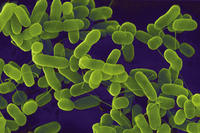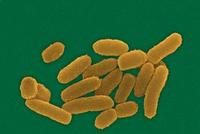-
Argonne software help decode German E. coli strain

In the early days of annotating genomes in the mid-1990s, it took four or five scientists more than a year to analyze just one genome; now, with the help of Rapid Annotation using Subsystems Technology (RAST), which was developed by Argonne scientists, researchers needed only eight hours to sequence the genome of the rogue E. coli strain which struck Europe this summer; the next-generation RAST will cut this time to just fifteen minutes
-
-
Former colleagues: accused anthrax killer could not have done it
Two former colleagues of Bruce Ivins, a scientist who worked at the U.S. Army Medical Research Institute of Infectious Disease (USAMRIID) in Frederick, Maryland, and who was accused by the FBI of being behind the 2001 anthrax attacks in the United States, said he could not have done it (Ivins committed suicide in July 2008)
-
-
Virus movement in Wisconsin groundwater
Drinking water taken from a deep aquifer protected by a semi-permeable layer of rock should be safe because the water is protected from many contaminants, including viruses — but is it safe? University of Wisconsin scientists find virus particles in many deep Madison, Wisconsin water wells, raising questions about how viruses, which should not survive more than two years underground, reached so deep and survive for so long
-
-
Listeria outbreak grows worse, 18 dead and 100 sick

The nation’s deadliest food-borne outbreak in a decade continues to grow worse with the Centers for Disease Control and Prevention (CDC) reporting a total of eighteen deaths from listeria-infected cantaloupe
-
-
Anthrax vaccine contract worth up to $1.25 billion over five years
Emergent BioSolutions has been awarded a contract to supply the U.S. government with FDA-licensed anthrax vaccine; the 5-year contract a has a total value of up to $1.25 billion; the first 8.5 million doses will be delivered before the end of the year
-
-
Millions of yet-to-be-described viruses found in raw sewage

There are roughly 1.8 million species of organisms on planet Earth, and each one is host to untold numbers of unique viruses, but only about 3,000 have been identified to date; a new study reveals a vast world of unseen viral diversity that exists right under our nose — in ordinary raw sewage, to be precise
-
-
Contaminated cantaloupe outbreak deadliest in decade

The recent listeria outbreak that has sickened seventy-two people and killed as many as sixteen, is shaping up to be the deadliest U.S. food-borne disease outbreak in more than a decade
-
-
Elusive killer parasite being traced in Peru
Chagas disease, primarily seen in South America, Central America, and Mexico, is the most deadly parasitic disease in the Americas; Penn epidemiological study takes snap shot of long-term Chagas disease outbreak
-
-
Mapping the spread of drug-resistant influenza

The movie “Contagion” is not based on real events, but it is not science fiction, either: certain strains of influenza are becoming resistant to common treatments; a team of researchers map out how this phenomenon is happening globally
-
-
Budget cuts could hurt biodefense efforts

With lawmakers struggling to reduce spending and cut the deficit, funding for government programs aimed at thwarting biological threats could face severe budget cuts; while the budget for overall civilian biodefense increased by 17 percent, that number is deceiving as federal agencies consolidated and combined several key programs under larger budget line item headings
-
-
Scientists "domesticate" -- and disarm -- malaria parasite
Malaria is one of the Earth’s most notorious scourges, accounting for more than 250 million new cases — and one million deaths — each year, researchers have developed a novel technique to “tame” the malaria parasite by forcing it to depend on an external supply of a vital chemical; this could help to speed up drug development and provide the basis for the first effective vaccine against malaria
-
-
Lawmakers struggling to end critical medicine shortage
Critical shortages for medicines needed in treating life-threatening illnesses have lawmakers and public health officials scrambling to find solutions; this year alone, a record high of more than 180 drugs crucial for treating childhood leukemia, breast and colon cancer, infections, and other diseases have been declared in short supply
-
-
Anthrax forensics help ID source of Haitian cholera outbreak
Researchers have discovered the source of the deadly cholera outbreak in Haiti that killed more than 6,000 people and sickened 300,000; the study determined that Nepalese peacekeepers brought cholera to Haiti, when they came to assist the country’s rebuilding efforts following the massive earthquake in January 2010
-
-
How did the deadly plague bacterium develop?

In a relatively short time — in evolutionary terms — a bacterium that causes mild stomach irritation evolved into a deadly pathogen responsible for the most devastating pandemics in human history; how did the mild-mannered Yersinia pseudotuberculosis become Yersinia pestis, more commonly known as the Plague? New study explains what happened — and sheds light on fighting deadly diseases
-
-
Experts anxious about appearance of a variant strain of Bird Flu

Since 2003 H5N1 has killed or forced the culling of more than 400 million domestic poultry and caused an estimated $20 billion of economic damage across the globe before it was eliminated from most of the sixty-three countries infected at its peak in 2006; the UN health agency now calls for increased preparedness and surveillance against a re-emerging variant strain of H5N1
-
- All
- Regional
- Water
- Biometrics
- Borders/Immig
- Business
- Cybersecurity
- Detection
- Disasters
- Government
- Infrastructure
- International
- Public health
- Public Safety
- Communication interoperabillity
- Emergency services
- Emergency medical services
- Fire
- First response
- IEDs
- Law Enforcement
- Law Enforcement Technology
- Military technology
- Nonlethal weapons
- Nuclear weapons
- Personal protection equipment
- Police
- Notification /alert systems
- Situational awareness
- Weapons systems
- Sci-Tech
- Sector Reports
- Surveillance
- Transportation
Advertising & Marketing: advertise@newswirepubs.com
Editorial: editor@newswirepubs.com
General: info@newswirepubs.com
2010-2011 © News Wire Publications, LLC News Wire Publications, LLC
220 Old Country Road | Suite 200 | Mineola | New York | 11501
Permissions and Policies
Editorial: editor@newswirepubs.com
General: info@newswirepubs.com
2010-2011 © News Wire Publications, LLC News Wire Publications, LLC
220 Old Country Road | Suite 200 | Mineola | New York | 11501
Permissions and Policies
